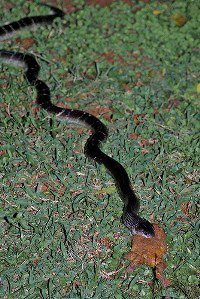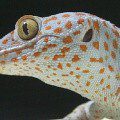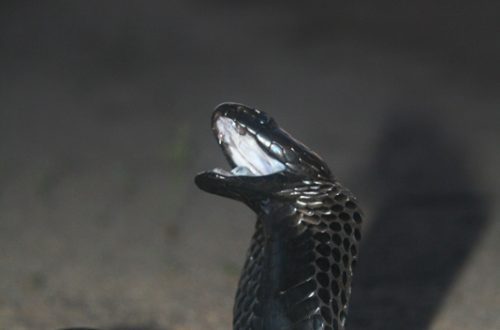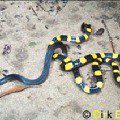
Krait Indian
Krayt or bungar takes second place (after cobra) in the twenty most poisonous snakes on our planet. This is a very dangerous snake, which also has an extremely unfriendly character. Half of all those bitten by kraits die even with the use of a special vaccine. The most dangerous is the yellow-headed krait, which, although it has small teeth, is the most deadly poison.
This snake lives in Australia, in South Asia and on the islands of the Malay Archipelago. Prefers dry places, rich in shelters (burrows, bushes, fallen trees). Very often it crawls onto cultivated lands, into yards, into people’s houses. Therefore, there are so many cases of snake attacks on people.
Classification
Kingdom: Animalia (animals)
Type: Chordata
Class: Reptilia (reptiles)
Order: Squamata (scaly)
Suborder: Serpentes (snakes)
Family: Elipidae (aspididae)
Genus: Bungarus (kraits)
Species: Bungarus caeruleus (Indian krait)
Inhabitation
The Indian region is widespread in Southeast Asia. This type of krait is most common in Sri Lanka and India. Prefers dry places where you can find rodent burrows, bushes, deadwood and other shelters. It is also found in settlements, cases of penetration into houses have been recorded.
Description

It is a medium sized snake (usually 120 to 150 cm long, although specimens as long as 180 cm have been recorded) with a characteristic triangular cross-section of the body. The head of the Indian krait is narrow, the border between it and the body itself is almost imperceptible. The scales of this species are smooth, of equal width, alternating transverse white (sometimes cream) and black stripes cover the surface from the neck to the tip of the tail. The body itself is painted brown or black on top, the belly is white in contrast. The dorsal keel is rather weakly expressed, the tip of the tail is pointed.
The venom of the Indian krait is highly toxic. For humans, the bite of this snake is deadly; in India, more people die from the bites of this type of krait than from those who were bitten by another snake, with the possible exception of a cobra. The glands located at the roots of the krait’s teeth contain 5 servings of poison, fatal to humans.
The activity peak of the Indian krait occurs at night. During the daytime, the snake prefers to be in hiding. The bright color of the snake can be misleading, but it is deadly. In a collision with a krait, in no case should you attack it. These actions will not frighten away the snake and will not force it to leave its familiar place. On the contrary, it will only provoke aggression. When meeting with an Indian krait, you just need to move away from it as far as possible. During the daytime, this snake is lethargic and lazy and is unlikely to engage in pursuit.
Food
The diet of the Indian krait consists of small snakes, amphibians and various lizards.
Reproduction
This is an egg-laying snake. After the laying is done, the female Indian Krait guards the laying on her own, until the moment the offspring is born.
Additionally
The Indian krait ranks second after the cobra in the TOP 20 most venomous snakes on the planet. More than half of human bites from krait are fatal, even when a vaccine is used.
Sources of
http://www.zmeuga.ru
http://www.zooeco.com
http://www.fb2book.com
http://www.alins.ru
http://www.floranimal.ru
http://mega.km.ru





